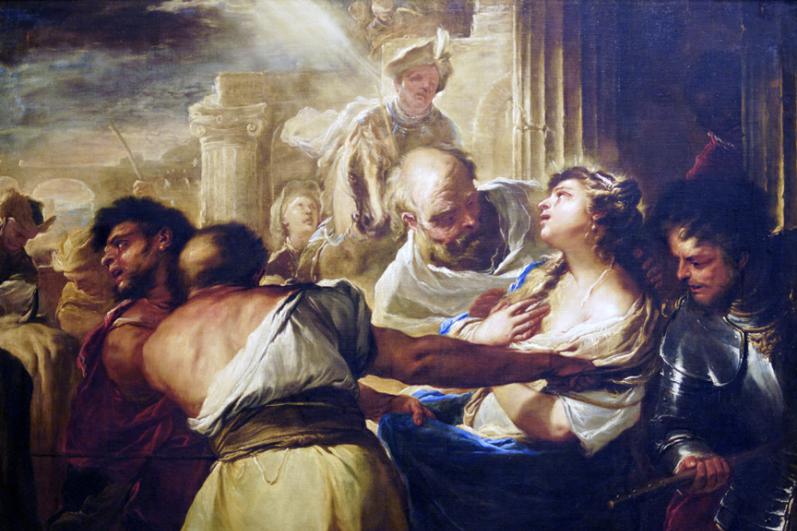See civilization getting made
In the old calendar, Dec. 13 occurred one week later, almost exactly at the time of the winter solstice, when the days start getting longer. It turns out that in 304 A.D. the solstice was the "dies natalis" of Santa Lucia of Syracuse, the day of her martyrdom. In her feast day and everything connected with it, we see civilization being made.
"Lucia" has the same root as the Latin word for light ("lux"), hence the association of this great saint with light. In many Christian countries, her memorial became a major feast day in preparation for Christmas, a weekday counterweight to Gaudete Sunday. That is why it makes sense for us, too, to reflect on her feast as the solstice approaches. "'Tis the year's midnight," as John Donne puts it at the beginning of his masterpiece, "A Nocturnal upon St. Lucy's Day," a poem of mourning for a lost lover.
Already with the mention of the solstice and this poem we see "civilization being made" right before our eyes -- as we see that an idealistic virgin saint, from a sunny island off the coast of Italy, who gladly gave everything away for Christ, has inspired a profoundly deep reflection, 1,300 years later, by a "metaphysical poet" 1,700 miles away, on a rain-drenched island off the coast of northern Europe.
If, like me, you are a Christian who has lost a lover, and who simply wants to be like what is best in both the saint and Donne, one from a persecuted, the other a recusant family, then you can easily see that they are speaking past the world and to each other, and, in your aspiration, you have already made yourself part of their polity and civilization, which begins here but which is and stretches into eternity.
Now let's take a step back. That 1,700-mile journey from England to Syracuse was difficult in times past but -- a testimony to the force of love -- was not infrequently undertaken over the centuries by pilgrims. The even longer and more difficult journey from Sweden was undertaken by Christian sailors as early as 1000 A.D. -- maybe in 1350, even, by St. Bridget or someone from her court. It is believed these pilgrimages were the source of what is today in Sweden a lively celebration of St. Lucy's day, which permeates their secular society, as does our own Christmas celebration.
Have you noticed so far five truths about how civilization is made? Four are derivative and one primary. The three are connection through place (pilgrimage), connection with nature (solstice), connection in the imagination (solstice/death), and connection by word (poetry, hymns).
The primary is the complete act of love of Christ shown in St. Lucia's martyrdom. A young girl from a wealthy family, Lucia became enthralled with the example of St. Agatha, who had died a virgin martyr 50 years earlier in nearby Catania. Lucia wanted to be "the St. Agatha of Syracuse," her own town. Such love is the very seedbed of Christian civilization. Hence, St. Pope John Paul II believed that the martyrs of the 20th century had planted sufficiently for a revival of Christian civilization in the 21st.
According to the tradition, St. Lucia gave away all her wealth and consecrated herself a virgin, following St. Agatha's example. But the man to whom she was promised in marriage was not pleased, to say the least, and from spite (money and "love" being the two common motives for crime) he denounced her to the pagan authorities. She was arrested and discovered indeed to be a Christian when she refused to burn incense to the emperor. Her punishment, deemed entirely fitting, was to be sold into prostitution. However, when the guards tried to drag her to a brothel, she proved to be immovable. Even ropes tied to oxen couldn't budge her. Naturally, then, the best recourse would be to pile wood around her and burn her as a witch. And yet neither could the flames affect her. According to some ancient accounts, they next gouged out her eyes -- that is why in some icons St. Lucy carries her eyes on a dish. In desperation, she was dispatched quickly with a short sword.
"Be good bankers," Our Lord used to say, according to an ancient oral tradition. If as a Christian you are not inspired and do not believe young Lucia to have made some shrewd trades (requiring much insight and nerve, no doubt), then you are in a minority.
Now take another step back. It is 1994, a concert of the Three Tenors on the world's stage after the Los Angeles Olympics. After singing some operatic arias, Pavarotti, Careras, and Domingo start celebrating the great nations of the world in song. For Italy, they pick "Santa Lucia Luntana" -- not the more familiar song made popular by Caruso, but another Neapolitan barcarole.
These "barcaroles" or boat songs from Naples were originally sung by men selling boat rides in the harbor, just offshore from the then seaside district, Borgo Santa Lucia, named after a basilica, built perhaps by the niece of the Emperor Constantine, and rebuilt many times since, most recently after its destruction in WWII.
The song named after the district named after the basilica named after the saint. There, civilization being made and remade: love of Christ, the beauty of nature, love of place, and the Christian imagination in word and song.
- Michael Pakaluk, an Aristotle scholar and Ordinarius of the Pontifical Academy of St. Thomas Aquinas, is a professor in the Busch School of Business at the Catholic University of America. He lives in Hyattsville, MD, with his wife Catherine, also a professor at the Busch School, and their eight children. His latest book is "Mary's Voice in the Gospel of John" available from Amazon.



















